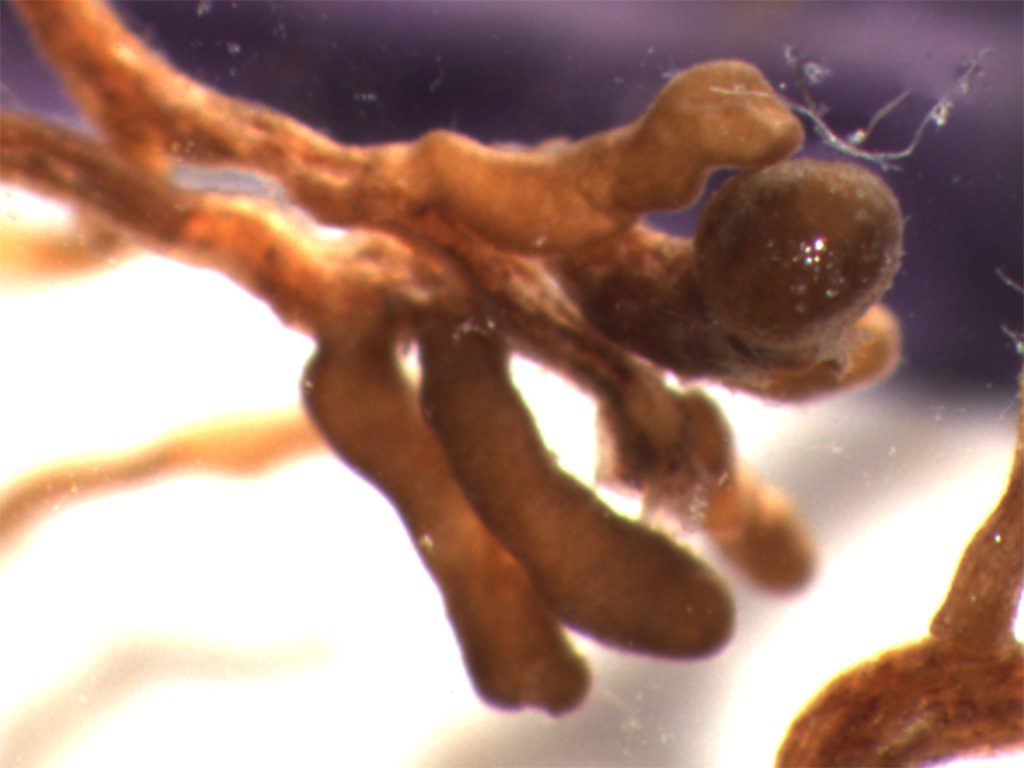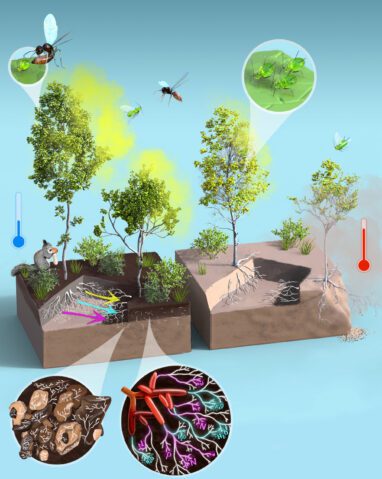
Click the image to view full size. Mycorrhizal fungi are known to provide a variety of crucial ecosystem services (left), whose depletion would leave us with much warmer, drier, more erodible, more simplistic, and less resilient natural areas (right). Illustration by Kara Gibson and Victor Leshyk. [1]
In addition to the benefits of each mycorrhizal symbiosis, studies suggest that mycorrhizal fungi form networks between plants underground (often called common mycorrhizal networks or the wood wide web), providing an opportunity for plants to share nutrients, water, and communications. Methodological challenges make demonstrating the existence, extent, and impact of common mycorrhizal networks on natural systems difficult, but their significance could be great, so this too is an active area of research.
Arbuscular mycorrhizal fungi (often referred to as AMF) evolved as root-like structures when plants moved to land approximately 450 mya. They are named for the site of exchange between the plant and the fungi, which looks like a small tree, and is found inside plant root cells.
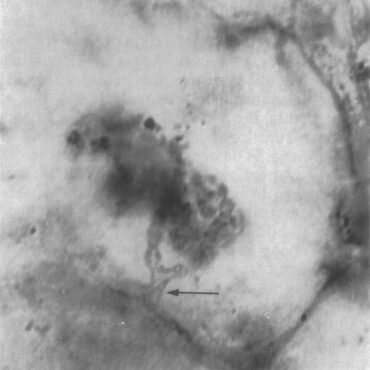
Arbuscular mycorrhizal fungi form tree-shaped exchange structures (known as arbuscules) inside plant root cells. A 400 million year old arbuscule is pictured here. Photo credit: Four hundred-million-year-old vesicular arbuscular mycorrhizae. Proc. Natl. Acad. Sci. 91:11841-11843. https://www.pnas.org/doi/pdf/10.1073/pnas.91.25.11841
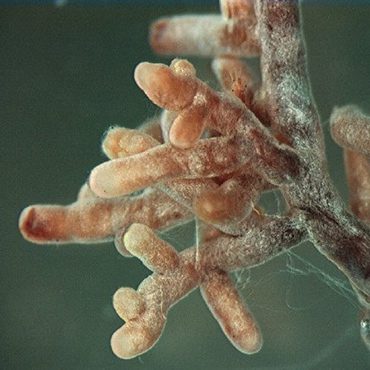
Ectomycorrhizal symbiosis, showing root tips with fungal mycelium from the genus Amanita. R. Henrik Nilsson, Erik Kristiansson, Martin Ryberg, Karl-Henrik Larsson (2005). “Approaching the taxonomic affiliation of unidentified sequences in public databases – an example from the mycorrhizal fungi”. BMC Bioinformatics 6: 178. DOI:10.1186/1471-2105-6-178.
Ectomycorrhizal fungi (often referred to as EMF) evolved at least 60 times that we know of (soft tissue fossils are not preserved as well as harder tissues like bone) over the last 150 million years, often from other life strategies such as being decomposer fungi. They are named for the site of exchange between the plant and fungus, which is integrated into the outside of plant root tips, making the root tips look swollen, rounded, or like they have a sock or adornment on them.
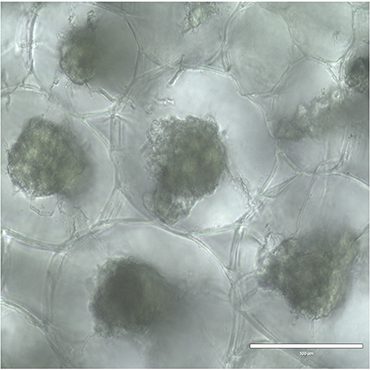
Orchid mycorrhizal fungi (OMF) form hyphal coils (known as pelotons) inside orchid root cells. Photo Credit: Dr. Jyotsna Sharma, Texas Tech University.
Other groups of plants have other groupings of mycorrhizal fungi, such as orchid mycorrhizal fungi (OMF), and ericoid mycorrhizal fungi. Orchids are known for being particularly dependent on their mycorrhizae, with some species of orchids being entirely dependent on their mycorrhizae for nourishment for years before the plants become photosynthetic.
Mycorrhizal fungal host specificity
The degree to which individual fungal taxa can work with one or more plant hosts can vary, but generally EMF are thought to be more specialized with particular hosts than AMF. The more generalist a fungi is, the less specialized benefit it may provide to its plant hosts. Sometimes mycorrhizal fungi can retain other life strategies, such as being a decomposer fungi as well. Some fungi could form different kinds of mycorrhizae (e.g. EMF and OMF), but the degree to which this happens is still under study.
Footnotes
[1] For details, see our publication: Cite as: Markovchick, L.M., Carrasco-Denney, V., Sharma, J., Querejeta, J.I., Gibson, K.S., Swaty, R., Uhey, D.A., Belgara-Andrew, A., Kovacs, Z.I., Johnson, N.C., Whitham, T.G. and Gehring, C.A. (2023), The gap between mycorrhizal science and application: existence, origins, and relevance during the United Nations’ Decade on Ecosystem Restoration (Figure 1). Restor Ecol e13866. https://doi.org/10.1111/rec.13866
Actual DOI: https://onlinelibrary.wiley.com/doi/full/10.1111/rec.13866
Shareable Link: https://onlinelibrary.wiley.com/share/author/UWXIBGKUBZMV5THXJWA3?target=10.1111/rec.13866
